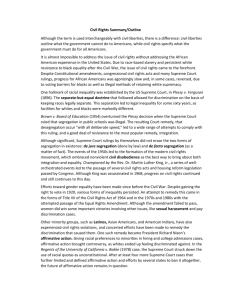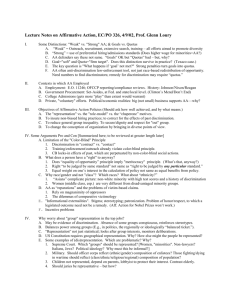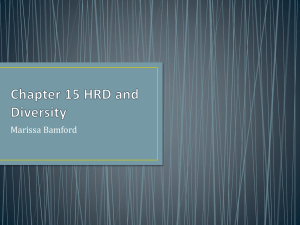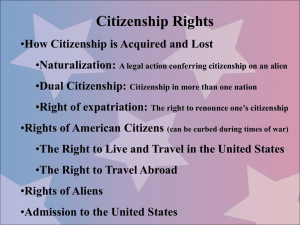SB Chapter 5
advertisement
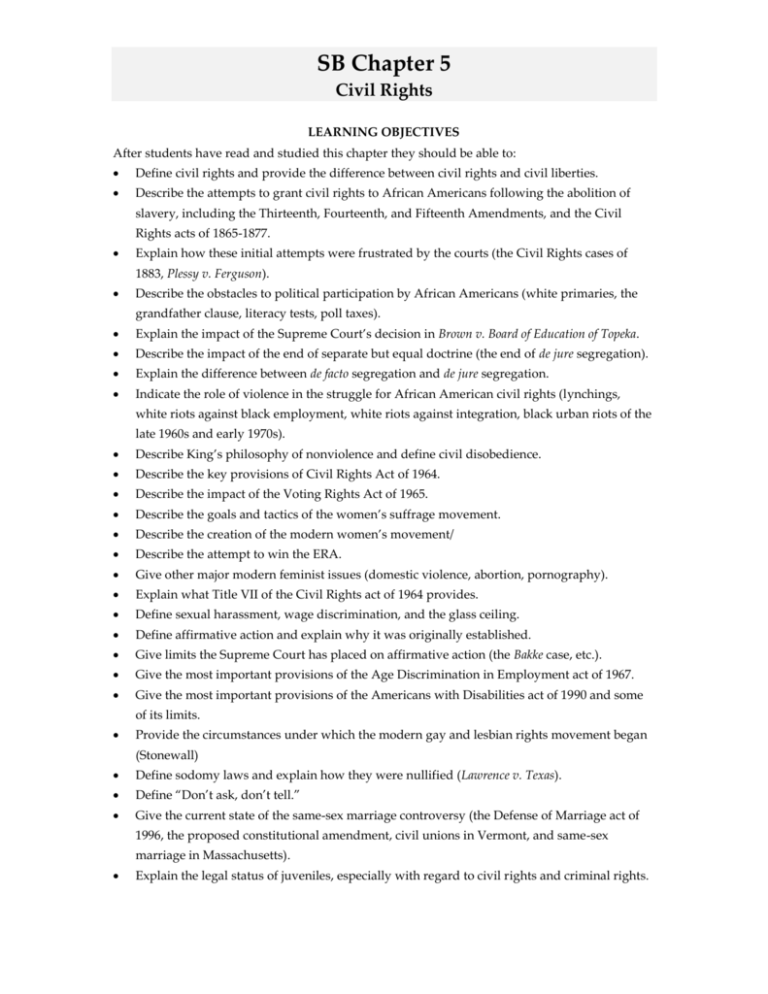
SB Chapter 5 Civil Rights LEARNING OBJECTIVES After students have read and studied this chapter they should be able to: Define civil rights and provide the difference between civil rights and civil liberties. Describe the attempts to grant civil rights to African Americans following the abolition of slavery, including the Thirteenth, Fourteenth, and Fifteenth Amendments, and the Civil Rights acts of 1865-1877. Explain how these initial attempts were frustrated by the courts (the Civil Rights cases of 1883, Plessy v. Ferguson). Describe the obstacles to political participation by African Americans (white primaries, the grandfather clause, literacy tests, poll taxes). Explain the impact of the Supreme Court’s decision in Brown v. Board of Education of Topeka. Describe the impact of the end of separate but equal doctrine (the end of de jure segregation). Explain the difference between de facto segregation and de jure segregation. Indicate the role of violence in the struggle for African American civil rights (lynchings, white riots against black employment, white riots against integration, black urban riots of the late 1960s and early 1970s). Describe King’s philosophy of nonviolence and define civil disobedience. Describe the key provisions of Civil Rights Act of 1964. Describe the impact of the Voting Rights Act of 1965. Describe the goals and tactics of the women’s suffrage movement. Describe the creation of the modern women’s movement/ Describe the attempt to win the ERA. Give other major modern feminist issues (domestic violence, abortion, pornography). Explain what Title VII of the Civil Rights act of 1964 provides. Define sexual harassment, wage discrimination, and the glass ceiling. Define affirmative action and explain why it was originally established. Give limits the Supreme Court has placed on affirmative action (the Bakke case, etc.). Give the most important provisions of the Age Discrimination in Employment act of 1967. Give the most important provisions of the Americans with Disabilities act of 1990 and some of its limits. Provide the circumstances under which the modern gay and lesbian rights movement began (Stonewall) Define sodomy laws and explain how they were nullified (Lawrence v. Texas). Define “Don’t ask, don’t tell.” Give the current state of the same-sex marriage controversy (the Defense of Marriage act of 1996, the proposed constitutional amendment, civil unions in Vermont, and same-sex marriage in Massachusetts). Explain the legal status of juveniles, especially with regard to civil rights and criminal rights. CHAPTER OUTLINE Civil Rights refer to those things that the government must do to provide equal protection and freedom from discrimination for all citizens. Traditionally, we think of civil rights as those rights rooted in the Fourteenth Amendment to the Constitution. While the term “civil rights” goes back in history, early attempts at true protection were unsuccessful because the Supreme Court believed that it was not within its purview to stop non-governmental discrimination. Since the 1950s, the Supreme Court has held the opposite view, thus enabling the government to offer broader protections to citizens’ equality in social and economic life. I. African Americans and the Consequences of Slavery in the United States A. Ending Servitude. With the passage of the Civil War amendments, slavery and some of the problems slavery had created were abolished. 1) The Thirteenth Amendment (1865) prohibits slavery within the United States. 2) The Fourteenth Amendment (1868) established that all persons born in the United States are citizens and no state shall deprive citizens of their rights under the Constitution. 3) The Fifteenth Amendment (1870) established the right of citizens to vote. B. The Civil Rights Acts of 1865 to 1875. After passing the Civil War Amendments, Congress enacted the Civil Rights Acts of 1865–1875, which were aimed at the Southern states. These laws attempted to prevent states from passing laws that would circumvent the amendments C. The Ineffectiveness of the Civil Rights Laws. 1. The Civil Rights Cases. The United States Supreme Court invalidated much of the civil rights legislation in the Civil Rights cases (1883). Enforcement of the Fourteenth Amendment was limited to correcting actions by states in their official acts. This would mean that private citizens could practice discrimination without interference from the national government. 2. Plessy v. Ferguson: Separate-but-Equal. The Supreme Court went further in this direction in 1892 in the case of Plessy v. Ferguson, where the Court held that “separate-but-equal” treatment of people of different races by state governments was not a violation of the Fourteenth Amendment. 3. Voting Barriers. The Fifteenth Amendment attempted to establish voting rights for all citizens, except females and some American Indians. However, some state governments enacted laws that circumvented the right to vote. (The white primary, the grandfather clause, poll taxes, literacy tests.) The effect of these laws virtually prohibited African American males from voting in many southern states. 4. Extralegal Methods of Enforcing White Supremacy. Lynching in the South, and in the North riots against the employment of African Americans. D. The End of the Separate-but-Equal Doctrine. 1. Brown v. Board of Education of Topeka. Plessy v. Ferguson was eventually overturned by the Supreme Court in 1954. In the case of Brown v. Board of Education of Topeka, the separate but equal doctrine was reversed. 2. “With All Deliberate Speed.” States were ordered to eliminate segregation policies with all deliberate speed. E. Reactions to School Integration. States that mandated segregation were outraged at interference in state issues by the national government. Serious riots against desegregation took place in a number of localities. F. An Integrationist Attempt at a Cure: Busing. Key concepts: De facto segregation—racial segregation that occurs because of past social and economic conditions and residential racial patterns. De jure segregation—racial segregation that occurs because of laws or administrative decisions by public agencies. 1. Court-Ordered Busing. A solution to both forms of segregation, it involved busing black students to predominantly white schools and vice versa. It was very unpopular among whites and not very popular among African Americans, either. It is not common today. 2. The End of Integration? By the 1990s the Court was willing in may cases to say that local schools had done enough to desegregate, and no further actions were necessary, despite the continued existence of de facto segregation. 3. The Resurgence of Minority Schools. Many African Americans and members of other minority groups now seek to improve the performance of their local schools rather than make them more balanced racially. II. The Civil Rights Movement The elimination of segregationist policies and racial intolerance would not have occurred without a strong civil rights movement. This movement began in the South and grew to a national scale. Although this movement included thousands and had many leaders the most famous leader was the Reverend Dr. Martin Luther King, Jr. A. King’s Philosophy of Nonviolence. One of the major reasons Dr. King was so successful was his philosophy of non-violent civil disobedience (a nonviolent, public refusal to obey allegedly unjust laws). 1. Nonviolent Demonstrations. Peaceful civil disobedience became the hallmark of the civil rights movement. 2. Marches and Demonstrations. This approach gained the support and respect of millions of Americans. What began as a small movement in the South quickly became a national mission. B. Another Approach: Black Power. Leaders such as Malcolm X advocated a more forceful approach than King. They also resisted the impulse to cultural assimilation that was implied by the integrationist philosophy. III. The Climax of the Civil Rights Movement. A. Civil Rights Legislation. 1. The Civil Rights Act of 1964. In response to public demands for action congress passed the Civil Rights Act of 1964. This law prohibited discrimination in the areas of: 1) voter registration, 2) public accommodations, 3) public schools, and 4) employment. The Equal Employment Opportunity Commission (EEOC), which was established by this law, was assigned the task of ending racial discrimination in the work place. 2. The Voting Rights Act of 1965. The enactment of the Twenty-fourth Amendment in 1964, which eliminated any tax for the purpose of voting, was a modern beginning of the end to racial discrimination at the ballot box. The Voting Rights Act of 1965 made state laws restricting political participation by minorities illegal. 3. Urban Riots. Even as the civil rights movement was winning victories, a series of intense civil insurrections spread through African American urban districts. The riots cost the movement considerable good will. 4. The Civil Rights Act of 1968 and Other Housing Reform Legislation. One of the major omissions of the 1964 act was discrimination in housing. In 1968, days after the assassination of Dr. King, the Civil Rights Act of 1968 became law. Part of this legislation prohibited racial discrimination in the area of housing. B. Consequences of Civil Rights Legislation. 1. Political Participation by African Americans. There are now many thousand African American elected officials. 2. Political Participation by Other Minorities. Other groups, such as Hispanics, have also increased the number of elected officials at all levels of government. 3. Lingering Social and Economic Disparities. Poverty persists, and is most prevalent among minority group members. How to address this fact is a major unresolved issue. IV. Women’s Struggle for Equal Rights A. Early Women’s Political Movements. Activism for women’s rights began with the Seneca Falls convention in 1948. B. Women’s Suffrage Associations. The early struggle for equal rights for women began focused on suffrage, or the right to vote. This struggle would continue for more than 70 years until the ratification of the 19th Amendment to the Constitution that states “The right of citizens of the United States to vote shall not be denied or abridged by the United states or by any State on account of sex.” C. The Modern Women’s Movement. The modern women’s movement started in the 1960s as a result of the awareness of rights caused by the civil rights movement. The publication of Betty Friedan’s The Feminine Mystique and the formation of the National Organization for Women were significant early developments. 1. The Equal Rights Amendment. A major initial goal of the modern women’s movement was the ratification of the Equal Rights Amendment, which states, “Equality of rights under law shall not be denied or abridged by the United States or by any state on account of sex.” The ERA was sent to the state legislatures for ratification on March 22, 1972. It failed to win the necessary 38 states’ approvals in the traditional seven-year limit. The Congress extended the time limit, but the states again failed to support the ratification of the ERA. Part of the opposition to the ERA came from an anti-feminist backlash. This conservative backlash asserted that the passage of the ERA would significantly alter social relations in the United States, and that men and women would be the “same” under law (rather than equal). 2. Additional Women’s Issues. Issues advanced by the women’s movement included domestic violence, abortion rights, and pornography (this last issue tending to divide the movement rather than unite it). 3. Challenging Gender Discrimination in the Courts. With the failure of the ERA, the women’s movement changed focus to challenge gender discrimination in the courts and through legislation. These efforts met with considerable success. 4. Expanding Women’s Political Activities. Organizations have been formed to promote greater representation of women in government. D. Women in Politics Today. 1. Women in Congress. There are a substantially larger number of women in Congress than ever before. 2. Women in the Executive and Judicial Branches. It is now normal for the president’s cabinet and the Supreme Court to contain a number of women. 3. Continuing Disproportionate Leadership. Men continue to be over represented in positions of power, however. V. Gender-Based Discrimination in the Workplace A. Title VII of the Civil Rights Act of 1964. This title prohibits gender discrimination in employment. This has been used to protect women from workplace discrimination. In 1978, Title VII was amended to include the condition of pregnancy. B. Sexual Harassment. The Supreme Court also has held that Title VII includes prohibitions on sexual harassment. Some problems with addressing sexual harassment complaints are how to define a “hostile environment.” The Court has attempted to clarify the issue. C. Wage Discrimination. In the year 2010, women will comprise a majority of the U.S. workforce. Yet women, in spite of Title II and legislation such as the Equal Pay Act, women, on average, continue to earn less than men. In 2002, a woman earns 76 cents for every dollar made by a man. 1. The Equal Pay Act of 1963. Employers cannot establish separate pay scales for men and women performing the same work. 2. The Glass Ceiling. This term refers to hard-to-identify but very real barriers to the promotion of women into positions of authority. VI. Affirmative Action Affirmative action describes those policies that give special preferences in educational admissions and employment decisions to groups that have been discriminated against in the past. As originally intended, affirmative action policies were an attempt by the federal government to “level the playing field” for women and African Americans in particular. The policy of affirmative action goes beyond a strict interpretation of the equal protection clause. Affirmative action remains a controversial issue for several reasons. Some people argue that racial and gender-based discrimination in employment and school admissions decisions is now so infrequent that affirmative action is no longer warranted. Others argue that the “backlash” created hurts race relations. Some women and African Americans argue that the presence of affirmative action discredits their achievements. On the other side of the argument are the economic realities. There is no doubt that women and African Americans lack economic parity in the U.S. Affirmative action represents one attempt to remedy this. Popular support of affirmative action programs seems to be based somewhat on racial identity, with majorities of African Americans and Hispanics supportive of affirmative action, and whites widely divided on the issue. A. The Bakke Case. In Regents of the University of California v. Bakke (1978) the Supreme Court ruled that quota systems that only considered the race of an applicant were unconstitutional. The court’s decision applied only to situations where race was the sole factor being used. B. Further Limits on Affirmative Action. In another decision, Adarand Constructors, Inc. v. Peña, U.S. Supreme Court ruled that when governments use affirmative action programs, it must do so under the “strict scrutiny” rule. This means that governments typically cannot use quota systems, and once a program has been deemed successful, it must be eliminated. In two University of Michigan cases in 2003, the Court indicated that “diversity” was a legitimate goal in college admissions, but could not be achieved by automatically assigning “points” to minority applicants. C. State Ballot Initiatives. One form of backlash against affirmative action has been California’s Proposition 209, which, through a ballot measure, ended all statesponsored affirmative action programs. Similar ballot measures currently are under consideration in other states. VII. Special Protection for Older Americans The number of people over the age of 65 is growing dramatically. A. Age Discrimination in Employment. B. The Age Discrimination in Employment Act of 1967. The Age Discrimination in Employment Act of 1967 prohibits discrimination by age in all but a limited number of occupations where age is considered relevant to the job. Also, many individuals do not desire retirement when they reach the age set as the retirement age by a company or government, and mandatory retirement has progressively been made illegal by laws passed in 1978 and 1986. VIII. Securing Rights for Persons with Disabilities A. The Americans with Disabilities Act of 1990. The most significant development for the disabled to date was the passage of the Americans with Disabilities Act of 1990. This legislation prohibits job discrimination against individuals with physical or mental disabilities. Furthermore, it requires physical access to public buildings and public services. In 1998, the Supreme Court ruled that persons infected with the HIV virus are protected by the ADA. This means that such employees must be accommodated. B. Limiting the Scope and Applicability of the ADA. The Supreme Court has limited the scope of the ADA. In 1999, the Court held that the ADA did not protect persons who wear eyeglasses. In 2002, the Supreme Court ruled that carpal tunnel syndrome, a repetitive stress injury, does not constitute a disability under the ADA. In most cases, state citizens cannot sue their state under the ADA. IX. The Rights and Status of Gay Males and Lesbians A. Growth in the Gay Male and Lesbian Rights Movement. The modern movement is conventionally held to have begun following the Stonewall incident, where gay men (and others) rioted against a police raid on a bar frequented by gays. B. State and Local Laws Targeting Gay Males and Lesbians. In the 1960s every state except Illinois had laws that banned sodomy, that is, various proscribed sexual practices including homosexual practices. During the 1970s and early 1980s many states repealed such laws. The repealing of such laws halted in 1986, with the case Bowers v. Hardwick, when the Supreme Court upheld a Georgia law that banned homosexual conduct between adults. In Lawrence v. Texas (2003), however, the Court reversed itself and effectively struck down all remaining sodomy laws across the country. In the 1996 case Romer v. Evans, the Supreme Court ruled that a Colorado constitutional amendment that invalidated state and local laws that protected gay males and lesbians from discrimination violated the equal protection clause of the U.S. Constitution. Since Romer, many states and cities have passed measures that afford protection to gay men and lesbians in housing, employment, public accommodation and credit. C. The Gay Community and Politics. Gay activists now play a role in both major parties. Eleven open gay men or lesbians sit in the House. D. Gay Men and Lesbians in the Military. The “don’t ask, don’t tell” policy, a compromise instituted under President Bill Clinton, purports to provide some protection against dismissal to gays in the military, but in fact has been relatively ineffective. E. Same-Sex Marriages. In 1993, the Hawaii state Supreme Court raised the issue of whether the state constitution protected the rights of same-sex individuals who sought a marriage license. Congress responded with the Defense of Marriage act of 1996, which allowed states to refuse to recognize same-sex marriages performed in other states. (In Hawaii, voters amended the state constitution to ban same-sex marriage.) In Vermont, the state Supreme Court ruled that gay men and lesbians are entitled to the same benefits of marriage that opposite-sex couples enjoy. The Vermont legislature has passed a law permitting “civil unions” between same-sex couples.
